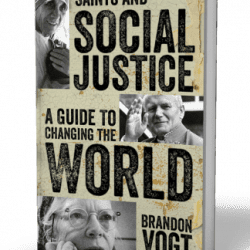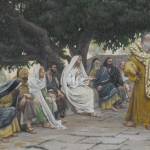In the last entry of the Exegesis, Philip K. Dick is suggesting his work has come to an end. He has become a whole person. He now believes that a higher, unfallen aspect of himself has been helping direct his fallen, incarnated self and now that he has discerned this, the two can come together and form one whole person:
What I realized is: true existence requires experience of both Yang and Yin: I saw them as two rings, a bright one of light (Yang) and a darker one of Yin. But the latter still real and necessary. […] What was experienced last night in my vision of the dark – or darker ring – or circle – of Yin is that, as Ted Sturgeon speaks of, you voluntarily incarnate (e.g., as I did in 1928 as PKD) to deliberatively experience Yin: creatoreal, irrational existence here (as bodhisattva) in order to know and be Yin. The Yang side is the bright unfallen side in and salvador salvandus, one’s other – rational – self, who enters in order to rescue the Yin or limited or darkened, incarnated self. This is why the inbreaking of the Yang side (2-3-74) is anamnesis: recovered memory of one’s own lost true self. This is also an extricating yourself from the maze by first being outside the maze – i.e., having solved it. Otherwise, fruitless horizontal tracking goes on forever; once (voluntarily) incarnated you are stuck there (here) forever. So I am a unitary whole now, with one part as a direct antecedent from the upper realm (Thomas) and one (PKD) from the lower realm.[1]
If PKD had not said similar things before, this would be a very haunting entry, suggesting that PKD had indeed gained some sort of insight, that he had finally knew how to get out of the maze of life and, having come to know this, he exited life as proof of his discovery. But one who reads the whole Exegesis suspects that, if he had not passed out due to a stroke, he would quickly find a new avenue of exploration, a new way of trying to understand his life in relation to his 2-3-74 experience, and this “aha” moment would be just one of a series of such moments written down by PKD.
It is very difficult to properly describe, let alone explain, the significance of PKD’s Exegesis. On one level, it can be read as the babbling of someone who lost his sanity in the 1970s. I am sure many will read it this way – though, as the brief commentary in the book points out, one of the things which makes this a problematic reading of the text is PKD’s own questioning of his sanity, an action which someone who is insane would not do. Something seemed to happen to him on 2-3-74, and those around him experienced some of the oddity itself. He came to know things he should not have known, such as his son’s inguinal hernia, which suggest some level of authenticity for his experiences. But, since he had to decode those experiences, since he had to interpret them and try to find out how they would fit in with known scientific, philosophical and theological theories, his work is best to be read as several attempted explanations or exegeses, with some which are quite credible, and some which seem to be pure bunk. We are shown his thought processes, we see the sources he chooses as tools to help interpret his experiences, and, if we decide to engage the text, we end up agreeing with some of his thoughts while utterly dismissing others as absurd. There is no way one can accept everything which PKD ponders – not even PKD himself does so. The value, however, is in the exploration of ideas, to uncover the diamonds in the rough contained within the long, meandering text.
Even when he hits on ideas which seem crazy, as perhaps this last entry, if we look deeper at it, if we engage it, we can see behind it ideas which are not really so crazy, and indeed, hint at ideas which even the long-standing orthodox Christian community accepts but has difficulty in expressing. We know the original intention for every human person, as they are created by God, differs from what a person makes of themselves; the two diverge as if two different persons, though salvation is the process by which the fallen person finds themselves restored to their unfallen state through the healing grace of God. As for the deliberate decision to incarnate in a fallen manner, Sergius Bulgakov sees original sin in a way similar to PKD’s explanation:
This idea must be liked with the more general idea (see above) that man himself participates, in a certain sense, in his own origin, accepting his being from the Creator. And this acceptance is characterized not by monotonous sameness but by the individual qualifiedness of self-determination. Every person pre-enacts Adam’s fall (with differences in mode and intensity). Every person repeats this fall, as it were, by his agreement to enter into a world damaged by Adam’s sin, thus accepting the infirm human nature, the sick flesh that already bears the seeds of death. This acceptance becomes equivalent here to the acceptance of being in general, for after Adam’s fall there is no other world, no world without sin.[2]
The fall is a choice to be in the world, and thus, an acceptance of the world as it is; PKD helps give an explanation for the good behind why we do this, even if in doing so, we would end up contaminated by sin: compassion. We go into the world, get contaminated for it, but yet we find a sense of loyalty to and for the world, and we enter as “bodhisattvas” to make it better, even if we know by doing so we will sink down in its mire. God, of course, is necessary for this to work – we need him to lift us up if we are to help save the world – but, in the incarnation, and the cosmic work of the incarnation as suggested by Scripture, God is shown to approve the task and transform it into his own even as he heals us from the consequences of abandoning him for the sake of the world.[3]
When not in the midst of self-doubt, PKD demonstrates a great sense of mission – that there is some great narrative being explained by his major novels, with his Exegesis in a way becoming the key by which we are to understand them and see how they explain our world situation and the way we are to get out of it. The fallen powers – whatever they are – are onto him, and try to subvert his work. Blade Runner is a case in point; while he was fascinated with what he saw of the movie, he also saw how the film, in its own contours, changed his vision; the movie studios tried to get him to write a novelization of the film and to take out of circulation the novel the movie was based upon; if he had done so, the powers that be would have succeeded in subverting his message, but because he held out against this, Blade Runner would point people to the original and from there, they would get the message that the movie tried to blot out:
My god, this movie is the greatest defeat (what was done to the book) and victory (the Tagore kerygma promulgated); the first is ostensible, the latter cryptic. Oddly, the first appears ostensibly to be a victory but really is a defeat; nonetheless, a real victory lucks secretly under it, but it is not the victory that people will think the making of a movie from my book is.[4]
The world tempts us to follow its ways; if you get a book made into a movie, an author is to feel as if there work is a success, even if the movie radically departs from the book’s vision. PKD, however, was adamant that he would keep his original book pure – while appreciating the movie for what it was. The book explores the dangers of the artificial, and gives a semblance of a hell-like world, a black iron prison, the kind of world we need to be liberated from. The movie, however, glorifies that prison – by making Deckard a replicant, the whole story and message is turned upside-down.
There are many twists and turns in PKD’s Exegesis. There is the question of who or what contacted him; at times, he got the sense of a person (Thomas) engaging him, indeed, merging with him – who is that person? Thomas appears to be from the first century, a Christian; is it reincarnation? It is contact with someone who is dead? Someone in another universe? Each time PKD answers these questions differently, his vision changes. Did the early Christians have a sense of “time travel,” and work through the chains of DNA to engage such travel? Was this the means Thomas used to interact with him (PKD saw that if one put fish signs together, they could merge to resemble the double-helix of DNA)? Sometimes, it is clear, PKD is thinking these answers out as a way an author tries to figure out what is going on in his story, and so, it is not surprising he tosses aside answers which he himself finds unconvincing, soon after he makes them. Even when we see many such crazy answers in the work, the book is valuable because it shows that we should risk asking questions, we should risk exploring ideas which we might think are unfounded to see where they lead, because this is the kind of work we need to do if we want to come to any form of understanding of our place in the world. It shows the willingness we need to explore every notion, every idea, and the brutal honesty we need to have as we do so; for in the process, even if the initial notions are unsound, we can stumble upon some great insight, one which makes the process itself worthy of human dignity. If we can lean on his example and use it to justify our own thought experiments, we have gained much and his work is indeed a success.
[1] Philip K. Dick, Exegesis. ed. Pamela Jackson and Jonathan Lethem (Boston: Houghton Mifflin Company, 2011), 894-5.
[2] Sergius Bulgakov, The Bride of the Lamb. Trans. Boris Jakim (Grand Rapids, MI: William B Eerdman’s Publishing Company, 2002), 184. “The relation of the human spirit to its nature, which is one for all humankind, is established in him. For all humankind, all of Adam’s descendants, there is now no choice between the world in the state before Adam’s fall and the state after it. For his descendants the only choice is to be or not to be in this world, which is in a state that should not be; but this acceptance of being, this to be, includes an infinite number of individual self-determinations and gradations. This self-determination takes place not in time, as it did for Adam and Eve, but above time; however, it is directed at time and is, as it were, simultaneous with Adam, as in Adam,” ibid., 185.
[3] “Premise: the primordial Fall was caused by our – by us, not our ancestors – making the error of taking the spatiotemporal realm to be real,” Philip K. Dick, Exegesis, 624.
[4] Ibid., 825.












